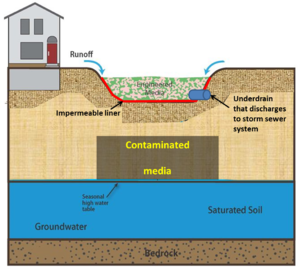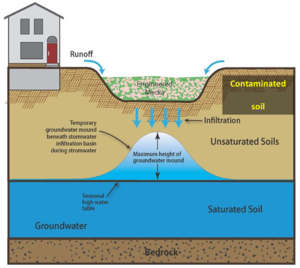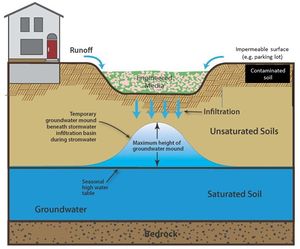
Difference between revisions of "Stormwater infiltration and contaminated soils and groundwater"
m |
m () |
||
| Line 1: | Line 1: | ||
= = | = = | ||
| − | [[File:Technical information page image.png| | + | [[File:Technical information page image.png|left|100px|alt=image]] |
[[File:Pdf image.png|100px|thumb|left|alt=pdf image|https://stormwater.pca.state.mn.us/index.php?title=File:Stormwater_infiltration_and_contaminated_soils_and_groundwater_-_Minnesota_Stormwater_Manual.pdf Download pdf]</font size>]] | [[File:Pdf image.png|100px|thumb|left|alt=pdf image|https://stormwater.pca.state.mn.us/index.php?title=File:Stormwater_infiltration_and_contaminated_soils_and_groundwater_-_Minnesota_Stormwater_Manual.pdf Download pdf]</font size>]] | ||
[[file:Contaminated site 2.png|300px|left|thumb|alt=schematic of contaminated site|<font size=3>Schematic for site where infiltration is not feasible. Note impermeable liner and discharge from underdrain to storm sewer system. For a discussion of considerations at sites with on- or off-site contamination, see [[Overview of considerations for sites with on-site and off-site contamination|this page]].</font size>]] | [[file:Contaminated site 2.png|300px|left|thumb|alt=schematic of contaminated site|<font size=3>Schematic for site where infiltration is not feasible. Note impermeable liner and discharge from underdrain to storm sewer system. For a discussion of considerations at sites with on- or off-site contamination, see [[Overview of considerations for sites with on-site and off-site contamination|this page]].</font size>]] | ||
Revision as of 21:44, 23 June 2021


Managing stormwater at sites with contaminated soils or groundwater is challenging because the infiltrated runoff has the potential to transport contaminants in the soil to the groundwater or mobilize contaminants in the groundwater. Stormwater at contaminated sites can be managed by surface capture and treatment, or as infiltration by avoiding contact between runoff and contaminated soils and groundwater. Surface capture includes filtration and sedimentation practices. When considering surface capture and treatment of runoff at contaminated sites, the surface capture treatment system will usually need an impermeable barrier to prevent infiltration and potential mobilization of contaminates in soil or groundwater. When considering stormwater infiltration at contaminated sites, it is essential to develop management options to ensure contaminants are not mobilized. To accomplish this, a project proposer must understand site conditions (e.g. soils, hydrogeology, land use), the nature and extent of contamination (i.e. site conceptual model), and applicable regulations. The following pages provide information on these topics, including case studies and links to additional information and guidance.
- Contaminated sites and stormwater infiltration
- Stormwater Infiltration and soil/groundwater contamination: A guide to the Construction Stormwater Permit requirements
- Screening assessment for contamination at potential stormwater infiltration sites
- Stormwater infiltration guidance for sites with known or high potential for soil or groundwater contamination on or off-site
- Links to Minnesota Pollution Control Agency cleanup and remediation information
- Case studies for stormwater infiltration at contaminated sites
- Links to information and guidance on stormwater infiltration at contaminated sites
- References for stormwater infiltration at contaminated sites
Related pages
- Overview of stormwater infiltration
- Pre-treatment considerations for stormwater infiltration
- BMPs for stormwater infiltration
- Pollutant fate and transport in stormwater infiltration systems
- Surface water and groundwater quality impacts from stormwater infiltration
- Stormwater infiltration and groundwater mounding
- Stormwater infiltration and setback (separation) distances
- Karst
- Shallow soils and shallow depth to bedrock
- Shallow groundwater
- Soils with low infiltration capacity
- Potential stormwater hotspots
- Stormwater and wellhead protection
- Stormwater infiltrations and contaminated soils and groundwater
- Decision tools for stormwater infiltration
- Stormwater infiltration research needs
- References for stormwater infiltration


